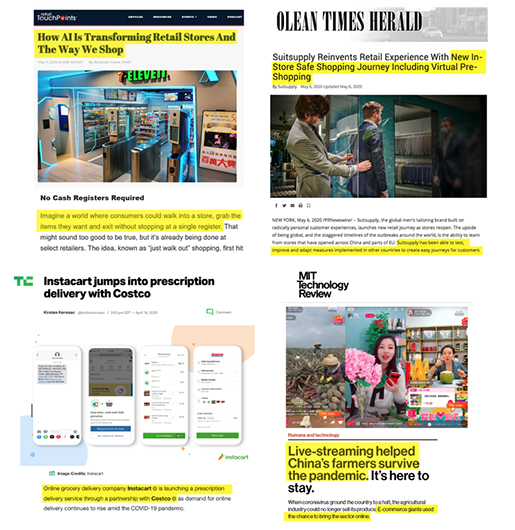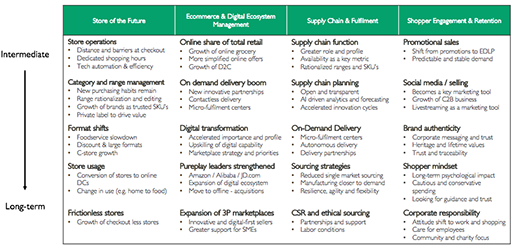- Membership
- The NY Chapter
- Our Career Services
- Committees
- National FACC Network
Brands & Retail: Reintegrating New Realities with a Solid Framework and Use Cases
Member news | June 12, 2020
The FACC-NY network is composed of a diverse mosaic of talented, experienced, and open-hearted professionals united by a desire to share their knowledge, nurture meaningful connections and succeed professionally. In this #MemberInsights series, we invite a guest member to contribute timely and relevant tips and insight for adapting your activities to overcome immediate challenges and plan for the long-term.
In this #MemberInsights feature, hear from Matthieu Dejardins, CEO & Founder, Next User. a company that connects website and social media data to activate unique insights into brands.
Realigning to immediate needs with a solid action plan for the “user journey of recovery”
A four-phase framework was designed by the renowned consulting firm Gartner which can be used to build your action plan to understand the impact of COVID-19 and to adapt your business operations.
Phase 1 (Mid-March 2020): your non-essential business suddenly closed, and you were forced to react immediately and manage it while working remotely. Sincerity and credibility were critical in terms of marketing message and, as a manager leader, you had to review your revenue plan and mitigate internal risks as well as risks to customers.
Phase 2 (June/July 2020): when your business re-open you will need to re-adapt to the new reality, re-align to immediate client needs and sharpen what you have already been doing. Your success will be determined by your ability to address your customer needs. You should mobilize your staff with safety training, reprioritizing your investments and using innovation opportunities as a competitive advantage. The user journey of recovery must be put into actions and you should find partners in order to improve the customer experience.
During these 2 phases technology becomes an integral component of your new normal. In the short term, communication becames key with major investments in unified conversation systems, eCommerce, data analytics, chatbot, and machine learning capabilities. In the long term, you will observe an increase in automation along with digital wallets and contactless retail.
Best practices and concrete examples of what should be short and long-term priorities
Change is crucial and not an option. As mentioned in the Wall Street Journal: “100,000 stores are expected to close over the next 5 years which represents more than triple the number that shut down during the previous recession”. Furthermore, “e-commerce will jump to a quarter of U.S. retail sales from 15% last year”, UBS estimates. We have seen significant changes happening in just a few months:
- Digital wallets and contactless retail: imagine a world where consumers could walk into a store, select the items they want to purchase and exit the store without having to stop at the cashier. For example, in Taiwan, 7-Eleven opened an experimental “X-store” in January 2018 with a cocktail of high-tech solutions which included: facial recognition, product identification, dynamic pricing automation, IoT system, intelligent voice system, RFID self-checkout and a payment system.
- Virtual tour by experts and safe shopping in-store: with 140+ retail locations around the globe, Suitsupply, a tailor brand, introduced screens and free-standing partitions for safe interaction without having to modify the customer’s behavior during pinning session. Guided virtual experiences with online experts available on their website assist clients in pre-selecting their products prior to physically visiting the store.
- Partnership, home delivery and convenience-store growth – partnering with Instacart, Costco added home delivery of prescription. Customers receive a text message with a link to schedule a delivery when their prescription is ready. Convenience store go beyond selling fresh produce, meat and seafood, to offering discounted prices and large formats made easy.
- Social media and live-streaming as a marketing tool – for instance, a flower distribution company with the logistical help of JD.com, one of China’s largest online retailers, started to help farmers use live-streaming to reach consumers with broadcasting on their app and JD Live to boost e-commerce. Following this success, JD.com and Alibaba created their own rural live-streaming events. This new marketing interaction model will remain in place to help create a direct contact with clients.
Framework to tackle every aspect of your retail and brand operations
The framework (below) will assist you in building your own set of initiatives pointing out the hot spots where you should innovate. Each topic was classified into 4 areas prioritized vertically from intermediate to long-term:
- Store of the future
- E-commerce and digital ecosystem management
- Supply chain and fulfillment
- Shopper engagement and retention
Each topic is detailed with a diagnostic for improvements that can be implemented according to the recent observations. We advise you to start with the following:
- Weekly meetings – to start selecting the right products, to determine how to enhance and regain your client relationships as well as to brief your team on new processes and safety measures.
- Next 30 days – to gauge the buyer’s engagement during your reopening, to adapt your marketing message to the “new realities” with relevant messaging and to start communicating it effectively to your prospects and existing customers.
- Next 90 days – to redesign your investment strategy on high-revenue opportunities, to implement innovation opportunities, to set future ambitions for new customers and redefine products for existing clients
Interested in connecting with Matthieu? Log into the FACC Member Directory to send him a message.





